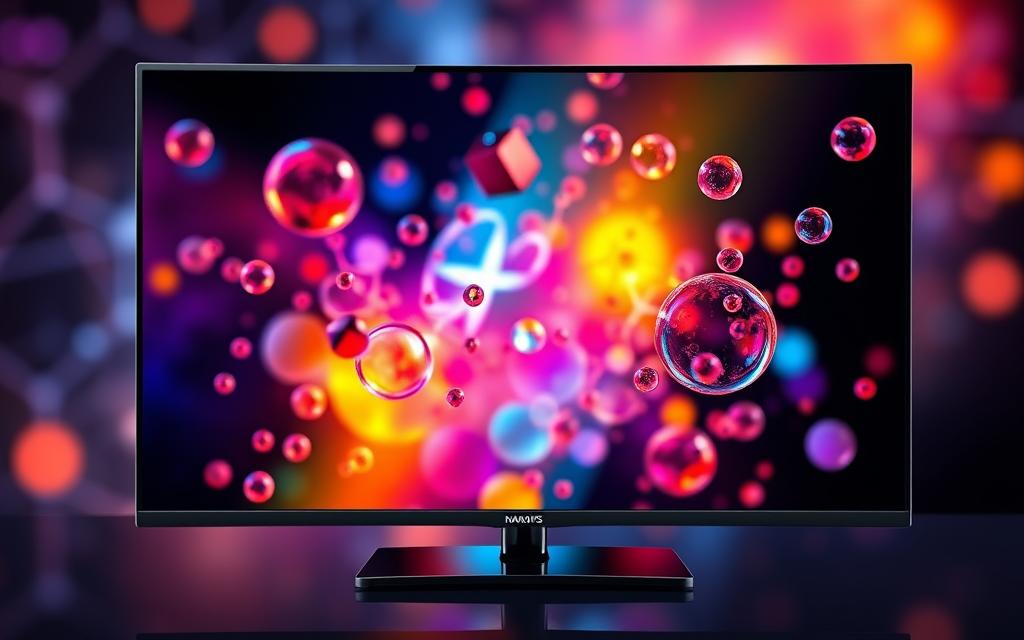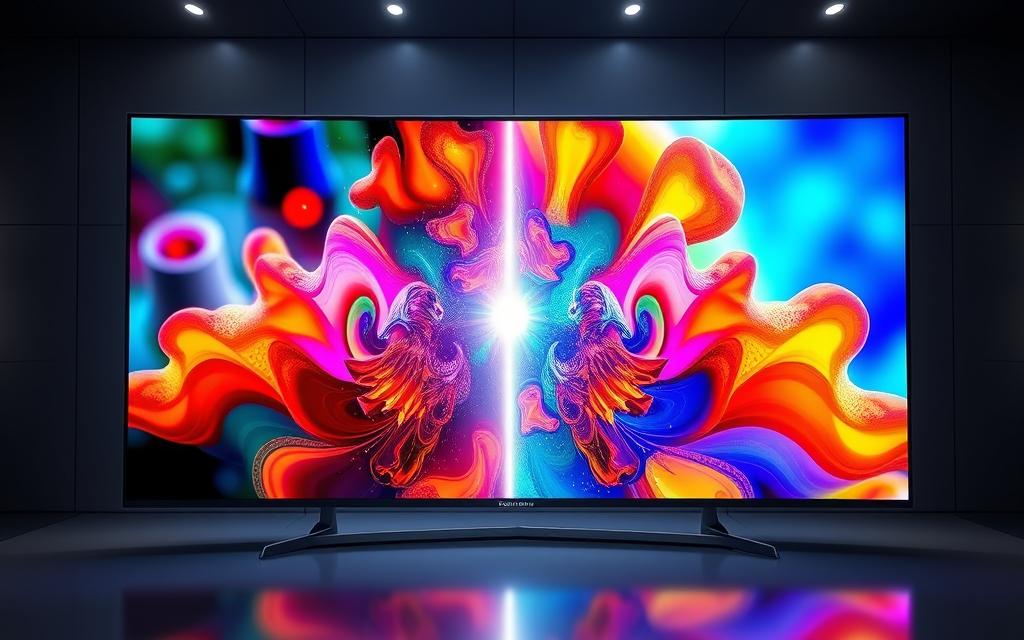What Is Nano IPS Technology and Why Is It Important?
Nano IPS technology is a big step forward in screen tech, introduced by LG in 2019. It adds a special layer of nanoparticles to the backlight of usual IPS screens. This boost colour accuracy and makes the view better. These screens can show up to 98% of the DCI-P3 colour space and 135% of the sRGB colour range. They are perfect for graphic designers, photographers, and gamers.
This upgrade offers top-notch image quality and quick response times as low as 1 ms. It also works well with adaptive systems like G-Sync and FreeSync. Thanks to Nano IPS, we get bright colours and better HDR quality. These displays are the top pick for experts who want the best visuals. For more insights on this tech, have a look at this detailed guide.
Understanding IPS Technology
In-Plane Switching (IPS) technology is a top choice for LCD panels because it boosts image quality. It places liquid crystals horizontally. This change significantly betters colour quality and viewing angles when compared to older TN panels.
What is Traditional IPS?
Traditional IPS panels stand out by offering true colour accuracy. This feature is especially crucial for graphic designers and photographers. It gives them vibrant images and a top-notch viewing experience.
Benefits of IPS Technology
IPS displays come with several benefits, making them a hit with professionals and everyday users alike. Key advantages include:
- Exceptional colour reproduction that looks vivid from various viewing angles.
- Wider viewing angles that allow multiple people to see accurate colours without any distortion.
- Enhanced image quality that’s perfect for working with graphics.
This tech’s outstanding colour precision and high performance make it a go-to in sectors where colour matters. It’s a vital tool for users who value quality above everything else.
What Is Nano IPS Technology?
Nano IPS technology is a big step forward from the usual IPS displays. It uses nanoparticles in the screen’s backlight to better it greatly. These tiny particles help to cut down unwanted light wavelengths. Because of this, Nano IPS can show more accurate colours and provide more vibrant visuals for a more immersive experience.
Introduction to Nano IPS
LG came up with Nano IPS technology in 2019. It improves upon basic IPS displays by finely adjusting how light particles are arranged. This nano-scale arrangement widens the range of colours and speeds up response times, matching TN panels. With over 98% DCI-P3 colour space coverage, it offers true HDR performance for realistic viewing.
How It Differs from Standard IPS
Nano IPS goes beyond standard IPS panels, which cover about 100% sRGB, by offering a wider colour range suited for HDR content. It’s made to fix old tech flaws, reducing motion blur and ghosting in fast scenes. Nano IPS panels boast response times as quick as 1 millisecond. This makes them perfect for both avid gamers and design pros. Their exceptional colour quality and responsiveness set Nano IPS apart for those seeking the best in visual performance.
The Science Behind Nano IPS
Nano IPS technology marks a huge leap in display tech. It uses tiny particles called nano-particles. These range from 1 to 100 nanometers. They improve the quality of what we see on screens. Nano IPS tech brings out the best in colour accuracy and display brightness.
Nano-particles and Their Functionality
Nano-particles set Nano IPS apart from usual IPS tech. These particles filter out certain light wavelengths, especially yellow and orange. As light from the LED backlights passes through these particles, primary colours—red, green, and blue—become more accurate. This leads to a wider range of colours. Manufacturers can cover about 98% of the DCI-P3 colour space.
How Light Filtering Enhances Colour Accuracy
Light filtering is key for better colour accuracy. Nano IPS screens produce very pure colours. This is due to how light interacts with the nano-particles. These displays surpass old IPS panels, which cover about 90% of the sRGB colour space. The improved light filtering means images are more vibrant and full of depth.

Advantages of Nano IPS Technology
Nano IPS technology takes screen quality to the next level. It provides several improvements over traditional IPS screens. Among its benefits are better colours, higher HDR performance, quicker response times, and wider viewing angles. This makes it a great choice for both work and play.
Wider Colour Gamut and Vivid Colours
Nano IPS can display up to 98% of the DCI-P3 colour space. This means it shows vibrant and true-to-life images. It’s perfect for everything from designing to watching movies, thanks to its colour accuracy.
Improved HDR Performance
With Nano IPS, HDR quality reaches new highs, with brightness over 1000 nits. This improves the range and detail in images, creating a more engaging viewing experience. It’s excellent for movie fans and gamers, as it keeps details in bright areas clear.
Faster Response Times
Nano IPS also boasts quick response times, going as low as 1 ms. This reduces blurring during movement, making everything look smoother. For gamers, this means better performance and clearer visuals during intense action.
Enhanced Viewing Angles
Last but not least, Nano IPS ensures colours stay vivid from every angle, up to 178 degrees. This is especially useful when sharing your screen, as it keeps the picture perfect for everyone watching.
Applications of Nano IPS Technology
Nano IPS technology is used widely across many fields. Colour accuracy and top-notch performance are crucial in these areas. It lets graphic designers, gamers, and video editors greatly improve their projects and enjoyment.
Importance for Graphic Designers and Photographers
Graphic designers and photographers hugely benefit from Nano IPS’s superior colour quality. These monitors aim for up to 98% DCI-P3 colour gamut. Thus, they showcase work with true-to-life colours. This helps in perfecting colour grading and creative work, giving more room to explore.
Utility in Gaming
Gaming sees great advantages from Nano IPS technology as well. It brings out fast response times and more vivid colours, crucial for an engaging game. This reduces visual lag and blurring. Players get smoother visuals, improving their performance and enjoyment.
Use Cases in Professional Video Editing
Video editing demands high precision, and Nano IPS technology meets this need. It gives editors the tools for editing with accurate colours. A wider colour range leads to consistent colour grading. So, creators can produce videos that stand out and meet professional standards.
Nano IPS vs. Other Display Technologies
In the world of display tech, there are many choices, each with its pros and cons. Nano IPS stands out when we compare it with TN and VA panels. Let’s dive deeper into how they match up.
Comparison with TN Panels
TN panels are known for their quick refresh rates, reaching up to 144Hz or more. This makes them a hit among gamers who crave speed. However, Nano IPS panels outshine TN in colour accuracy and viewing angles. TN panels struggle with colour quality and have narrow viewing angles, making them less ideal for colour-critical tasks.
Comparison with VA Panels
VA panels excel in contrast and colour vibrancy, which is great for watching videos or gaming. Yet, Nano IPS panels provide steadier colours and broader viewing angles compared to VA panels. Though VA is great for contrast and dark scenes, it may fall behind in colour consistency. This is crucial for professionals. Also, VA panels have slower response times, affecting action-packed games. Nano IPS, however, delivers well-rounded performance for various activities.
| Feature | Nano IPS | TN Panels | VA Panels |
|---|---|---|---|
| Colour Accuracy | Excellent | Fair | Good |
| Viewing Angles | Up to 178 degrees | Poor | Good |
| Refresh Rates | Varies (up to 360Hz) | High (100Hz-144Hz+) | Moderate (up to 240Hz) |
| Contrast Ratio | ~1,000:1 | ~1,000:1 | 2,000:1 to 4,000:1+ |
| Suitable Uses | Professional design, gaming | Competitive gaming | Media consumption, gaming |
Making the right choice in display tech can greatly affect your experience. Comparing Nano IPS with TN and VA panels can guide you to a decision based on your needs.
Conclusion
Nano IPS technology represents a major step forward in display tech. It brings improved colour accuracy and faster response times. These features benefit everyone, from professional designers to gamers.
This technology beats traditional IPS panels by offering more vibrant colors. It covers over 90% of the DCI-P3 colour space. This makes Nano IPS displays perfect for accurate digital projects.
The gaming world is always looking for better displays, and Nano IPS meets this demand. It has ultra-fast response times and high brightness levels. This makes games look better and more immersive.
Nano IPS is also great for work in graphic design and video editing. It gives the most accurate colours for professional projects. This helps professionals create their best work.
The future for Nano IPS tech looks promising. It stands at the cutting edge as we move towards better displays. Its superior quality and performance make it a key choice for top-notch display technology.
FAQ
What is Nano IPS technology?
Nano IPS technology is a big step up from normal IPS tech, created by LG in 2019. It boosts colour accuracy and offers colour range up to 98% DCI-P3. This makes images look better and improves reaction speed, great for both work and play.
How does Nano IPS differ from traditional IPS technology?
The key difference is the use of nanoparticles in the backlight by Nano IPS. These particles enhance how colours look and boost efficiency. Regular IPS panels usually hit about 90% of sRGB in colour coverage.
What are the main advantages of Nano IPS displays?
Nano IPS screens bring brighter colours, better HDR with brightness above 1000 nits, and quicker response times of 1 millisecond. Their angles for viewing are better too, providing sharp and consistent colours from different angles.
In which industries is Nano IPS technology primarily used?
Industries seeking top-notch colour precision benefit from Nano IPS tech. This includes graphic design, photography, and video editing. Gamers also prefer it for its quick response times and rich visuals.
How do Nano IPS displays stand against TN and VA panels?
Nano IPS tops TN panels in colour accuracy and viewing angles but TN might be quicker in response. Against VA panels, Nano IPS wins in colour and viewing angles but VA could have better blacks and contrast.
Why is colour accuracy important in display technology?
For professionals in design and photography, exact colour is key for beautiful work. For gamers, the right colours make the game more real and fun.
What advancements in HDR performance does Nano IPS offer?
By reaching over 1000 nits brightness, Nano IPS pushes HDR quality forward. This improvement makes images more lifelike, which is crucial for both entertainment and professional tasks.
How quick is the response time in Nano IPS displays?
Nano IPS screens manage response times as fast as 1 millisecond. This cuts down on blur and ghosting in fast games and videos, making everything smoother.
Is Nano IPS technology suitable for multi-user environments?
Yes, with Nano IPS, screens look vibrant and sharp from different viewpoints. This is perfect for teamwork and settings where many people are watching the same screen.
How does the colour gamut of Nano IPS compare to standard IPS?
Nano IPS shows more colours, up to 98% of DCI-P3, unlike standard IPS’s 90% of sRGB. This gives us more lifelike and bright images, essential for great visuals.














